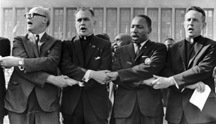
Political, educational, judicial and religious leaders will gather Oct. 9 (Tuesday) at the Smithsonian Institutions National Portrait Gallery to pay tribute to Rev. Theodore M. Hesburgh, C.S.C., president emeritus of the University of Notre Dame and one of the 20th centurys most influential figures in higher education, the Catholic Church and national and international affairs.
The invitational event will feature the inclusion of a photograph of Father Hesburgh into the National Portrait Gallerys permanent collection. The image, by an unidentified photographer, captures Father Hesburgh and the Rev. Martin Luther King Jr. linking hands in solidarity during a civil rights rally at Soldier Field in Chicago in 1964. Work in support of civil rights – marked most prominently by his service on the U.S. Commission on Civil Rights – was among the many major social issues in which Father Hesburgh was involved.
Notre Dame alumna and Secretary of State Condoleezza Rice is scheduled to attend and offer her reflections on Father Hesburghs legacy, and Sen. Edward Kennedy (via a pre-recorded video) and former Sen. Alan Simpson will be the evenings featured speakers. A video narrated by former CBS News anchor Walter Cronkite will recount Father Hesburghs long public service career and include taped tributes from former Presidents Bush and Carter. Anne Thompson, a correspondent for NBC News and a Notre Dame graduate, will serve as the evenings emcee.
White House, Congressional, judicial and other dignitaries are expected to attend the event, which also will celebrate Father Hesburghs 90th birthday (which was May 25).
Dozens of friends and associates of Father Hesburgh from Notre Dame, higher education, the Catholic Church, and other fields also will attend.
Father Hesburghs contributions to the nation and world, to the Church, and to higher education, including, of course, Notre Dame, are indelible,said Rev. John I. Jenkins, C.S.C., the Universitys president.This tribute at the Smithsonian is a much-deserved salute to a most remarkable man.
In addition to serving as Notre Dames president from 1952 to 1987, other notable achievements and accolades in Father Hesburghs career include:
- 16 presidential appointments – from President Eisenhower to the current President Bush – in which he was involved in most major social issues including civil rights, peaceful uses of atomic energy, campus unrest, Third World development, and immigration reform. In addition to the civil rights commission, other notable appointments were to the Presidential Clemency Board, charged with deciding the fate of various groups of Vietnam offenders, the National Science Board, Commission on the Holocaust, and Select Commission on Immigration and Refugee Policy.
- Service to four popes, three as permanent Vatican City representative to the International Atomic Energy Agency in Vienna from 1956 to 1970
- Service as chair of the International Federation of Catholic Universities
- Elected to the Board of Overseers at Harvard University, including two years as board president, the first priest in either position
- Service as co-chair of the Knight Commission on Intercollegiate Athletics
- The honor of being the first person from higher education to be awarded the Congressional Gold Medal, presented in 2000, and recipient in 1964 of the Medal of Freedom, the nations highest civilian honor
- Reception of 150 honorary degrees, the most ever awarded to one person
Father Hesburgh was born May 25, 1917, and raised in Syracuse, N.Y. He was educated at Notre Dame and the Gregorian University in Rome, from which he earned a bachelors degree in 1939. He was ordained a priest of the Congregation of Holy Cross, Notre Dames founding order, in 1943.
Following his ordination, Father Hesburgh continued his study of sacred theology at the Catholic University of America in Washington, D.C., earning his doctorate in 1945.He joined the Notre Dame faculty the same year and served as chaplain to World War II veterans on campus in addition to his teaching duties in the Religion Department.He was appointed the head of that department in 1948, and the following year was appointed executive vice president in the administration of Rev. John J. Cavanaugh, C.S.C., University president. At the age of 35 in June 1952, he was named the 15th president of Notre Dame.
The accomplishments of the Hesburgh era at Notre Dame are reflected in statistics comparing the Notre Dame of 1952, when Father Hesburgh became president, with the University he left in 1987.The annual operating budget rose from $9.7 million to $176.6 million, the endowment from $9 million to $350 million, and research funding from $735,000 to $15 million.Enrollment increased from 4,979 to 9,600, faculty from 389 to 950, and degrees awarded annually from 1,212 to 2,500.The two major changes during the Hesburgh era were the transference of governance in 1967 from the Congregation of Holy Cross to a two-tiered, mixed board of lay and religious trustees and fellows, and the admission of women to undergraduate studies in 1972.
The National Portrait Gallery was established by an act of Congress in 1962 and opened to the public in 1968. It is the only museum of its kind in the United States to combine aspects of American history, biography and art. The museums collection of nearly 20,000 works ranges from paintings and sculptures to photographs and drawings.
The National Portrait Gallery and the Smithsonian American Art Museum are housed in the Donald W. Reynolds Center for American Arts and Portraiture at Eighth and F Streets, N.W., Washington, D.C. More information is available on the Web at www.npg.si.edu
TopicID: 24746